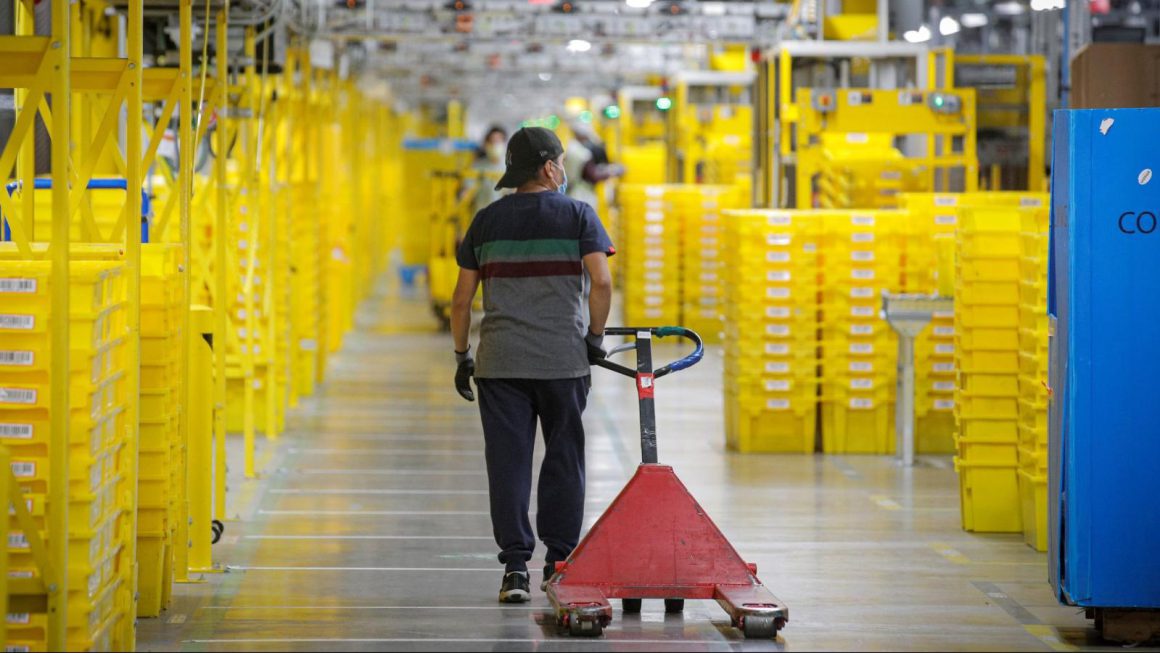By Dan O’Rourke
One of the core lessons of the pandemic has been that workers make society run. It certainly wasn’t billionaires, CEOs, landlords and bosses who were categorized as ‘essential workers’. That label was awarded to nurses, hospitality staff, couriers, bus drivers, and truckers. Workers are the ones who keep everyone healthy, fed. Workers are the ones who keep the shelves stocked by making and delivering everything required to live.
With lockdowns ending, the so-called ‘labour shortage’ in the US has further highlighted the essential nature of all workers. Without labour, bosses can’t make profits.
The pandemic has exposed the vulnerabilities and fragilities of capitalism on the one hand, and demonstrated the potential power of workers on the other. If utilised in a collective and coordinated way, this power gives workers the potential to win significant gains. This is how we win battles relating to pay, working hours, the climate, racial justice, ending oppression, and anything we need to live a safe, prosperous and dignified life.
One particular industry which has over-extended itself is the logistics industry. While rushing to grow in tandem with e-commerce, it is a perfect example of how capitalism weakens itself under competitive pressure by increasing the power of workers. The company that can get its product to the market first will win, and is the secret behind the growth of Amazon, Walmart and others. But it has built crucial weaknesses which could be exploited by an organised workers’ movement.
Announcement of Amazon warehouse in Ireland is part of a global trend
Transport workers, in general, were rightly recognised as essential workers. This included bus drivers, couriers and truck drivers. Warehouse workers were a less visible cohort, but just as essential to ensuring the day-to-day running of society. Transport workers have always had considerable power to win when they decide to strike. Transport work is recognised by Marx as a part of production — not just auxiliary to it. Also, it is much harder for the bosses to “offshore” warehouses when wages rise, because the location is the point of the warehouse. The growth in the number of warehouses has very specific implications for how workers can organise.
Bosses in the logistics industry are facing a deepening crisis, and the potential power of workers is growing. The ripple effects of the Suez Canal blockage, a shortage of shipping containers and the stop-start nature of the lockdowns, mostly in China, have seen ports around the globe suffer severe backlogs. Container ships are waiting for unprecedented lengths of times, sometimes months, to offload their cargo. These issues deserve closer examination, but this article will focus on logistics and warehouse workers.
While all sectors face similar issues, such as low pay, long hours, discrimination and exploitative working conditions, the warehousing and logistics industry in particular faces specific ongoing problems which are set to sharpen as we reach the end of the year. The long- and short-term trends influencing issues specific to logistics and e-commerce are worth examining in some detail.
Summer is typically a quiet period, but this June, July and August has seen an unprecedented shortage of warehouse workers. As the busy Christmas period looms, capitalists within the sector will face a crisis that presents opportunities for labour organising. The growth of e-commerce has placed a heavier burden on already exploited logistics workers. Consequently, if logistics workers consciously decide to drop this burden, significant gains can be won. The precarious, racialised, and increasingly automated nature of logistics work provides motivation for workers to fight back. However, it also presents challenges to organising.
Transport work is essential to all industries
The essential and interconnected nature of logistics mean a strike at a single pivotal warehouse or logistics company could have repercussions for hundreds of other companies. Transport workers hold the potential power to win significant gains in pay and working conditions for all workers.
For example, over the course of the Nabisco strike in the US, train drivers have refused to cross the picket line in delivering supplies to Nabisco factories. This crucial act of solidarity strengthens the strike and is an example that should be followed by everyone, from train drivers to bicycle couriers.
Very recently, a strike at the Sysco food distribution warehouse in Chicago had bosses in the restaurant industry worried. When 200 Sysco truck drivers walked off the job in support of the strike, the workers’ demands were met. The 1997 UPS strike led by the Teamsters union, saw significant gains won during a period of relatively low worker power. Further back, the 1934 Teamster Rebellion in Minneapolis was a pivotal point in the growth of the Teamster Union and showed the way forward in how workers can fight back. Other examples of powerful logistics strikes can be found here.
More generally, a two to three day strike by truck drivers would see all petrol stations run out of fuel. The recent Suez Canal incident was an example of how global trade can be obstructed if one of the many choke points around the world is blocked.
Logistics operations cannot be ‘offshored’
The problems faced by workers in each sector often overlap, but there are important differences worth examining on a sector-by-sector basis. For comparison’s sake, manufacturing workers such as the striking Nabisco workers, are faced with exploitative changes to their contracts relating to wages, pensions and overtime. Production being moved to another country is another threat to their jobs. A number of Nabisco plants recently moved to Mexico. Factories are often moved overseas in order to seek cheaper labour costs.
Logistics workers face similar problems relating to pay, overtime and working conditions. However, it rarely makes sense to move a port, a warehouse, or a delivery route to a different location. This is because the location is the purpose of the chosen site. Moving a warehouse away from an affluent city where wages are higher would only increase transport costs and delivery times. Thus, logistics operations are faced with a catch 22, typically not faced by manufacturing.
Long term growth of e-commerce is leading to increased need for warehouse workers.
The recent boom in the e-commerce industry, which was induced by the lockdown and temporary closure of brick & mortar outlets, has made Amazon boss, Jeff Bezos, the richest person in the world. With online ordering surging during the lockdown, the job of picking and packing products has transferred from the instore customer, to the warehouse where it is conducted by underpaid and overworked staff. However, this recent surge is part of a longer-term trend related to the growth of e-commerce. As online shopping grows, so does the need for small batch orders to be processed in warehouses, as opposed to in a shop or mall.
In 2018 online sales were 14% of global retail sales. That jumped to 19% in 2020 . The global e-commerce market size was valued at $10.6 trillion in 2020 and is expected to grow to a massive $27.15 trillion by 2027 . This indicates a clear move away from traditional retail and towards e-commerce, with its emphasis on logistics.
Amazon is investing further in its logistics capabilities as it aims to “put inventory closer to consumers”. Amazon is attempting to outdo traditional logistics companies such as UPS and FedEx in being able to get packages to delivered as soon as possible .
Many countries are experiencing a shortage of warehouse workers as retail and logistics companies strain to meet the demands of the boom in e-commerce. Speaking on the FedEx Q4 earnings call in June, COO Raj Subramaniam said,
“The inability to hire team members, particularly package handlers, has driven wage rates higher and creates inefficiency in our networks as we use overtime to cover open shifts and route volume around known constraints just as a few examples.”
This matches figures from the US Bureau of Labor Statistics. They show a sharp rise in warehouse workers, particularly since 2013 .
The UK is seeing a similar issue with job listings for warehouse workers reaching an unseasonal high in June, which is typically the quietest month of the year for warehouse work. While this is a momentary issue, it is indicative of a more long-term trend. Warehouse employment in the UK is forecast to grow, particularly in cities.
The Chinese retailer and e-commerce giant JD.com is opening more and more warehouses and investing heavily in logistics. It recognises that its competitive advantage lies in getting products to the end consumer as quickly and efficiently as possible. Their warehouse footprint has quintupled in five years.
Efficient logistical operations have been recognised by all retail companies as a key competitive advantage. Successful retail companies are, behind the scenes, actually successful logistics companies with a retail front. This is particularly the case for Amazon.
Big retailers such as Walmart, Target, HomeBase, Lidl and Aldi also fall into this category. All these companies’ competitive advantage is based on logistics. “Retailing does not have logistics — retailing is logistics” is the mantra of executives at retail companies .
Multiple crises
Another important factor in the growth of warehousing are the numerous crises slowing the steady flow of goods to the market. Retailers and manufacturers typically order parts and products to arrive at the shop or factory ‘Just in Time’ to be assembled or sold or. This means they spend less significantly money on expensive storage space, and the same amount on transport. However, this method is becoming increasingly difficult to manage for a number of reasons.
- Covid has caused the closure of multiple shipping ports, particularly in the important industrial region of China’s Pearl River Delta. This backlog is now dwarfing the head-line grabbing Suez canal blockage in March.
- In the EU and the UK, Brexit is causing ongoing uncertainty, prompting retailers and manufacturers to stockpile goods, often in outsourced warehouses
- The trade disputes between China and the US have meant an increase in the costs of certain goods, and the potential for future price increases as the two countries raise tariffs against each other.
- An artificial shortage of shipping containers was set off when global shipping slowed during the first lock down. This meant empty containers were not where they needed to be once production and trade picked up again. Without containers, nothing leaves the factories.
- Climate crisis: Storms, floods, and fires all increase the uncertainty of supply chains. Roads get washed out, ships are delayed, and the cost of shipping increases dramatically as a result of more volatile weather conditions. Unusually high winds were a factor in March’s Suez blockage.
All of these issues, among others, means there is a move away from the shipping and transport intensive ‘Just In time’ method and a move towards warehousing and stockpiling .
Warehousing- growing number of women workers
The global logistics industry in general, and US warehousing in particular, benefits greatly from artificial hierarchies that divide workers along racial lines. This means lower wages for workers and higher profits for bosses. At Amazon, Black and Latinx workers makeup 24.5 percent and 17 percent respectively of the total workforce — a total of 41.5% of the workforce, compared to 32% of the US population. At the recent Amazon union drive in Bessemer Alabama, “Black Lives Matter At Work” was a key demand. Up to 70% of the Amazon workforce in Bessemer are black . In the US more broadly, 21% of warehouse workers are black, compared to 12.5% in retail work.
In the UK immigrants are essential to keeping the sector up and running. In 2018 one quarter of warehouse staff were non-UK EU nationals.
While transport work in general is still a male-dominated industry, particularly shipping and docking, women are a growing part of the warehousing labour force, especially in the US. The BLS (Bureau of Labor Statistics) shows that women have gone from 18% of the warehouse workforce in 2015 to 34% in 2020. They are also more likely to be Black or Latina, in the US .
Increased automation will not replace workers in the short term, but may make warehouse work more specialised in the medium- to long-term. Automation is a major topic of discussion within warehouse industry reports and articles. Investment in automation is set to increase. However, the general consensus is that technology is not yet able to substitute many of the tasks required for warehouse work.
Robotics and automation are touted as a key source of the much sought-after “supply chain resilience.”
“Supply chain resilience has never been more important. Companies that made investments in digital technologies prior to the pandemic were more prepared and able to adapt, survive and even thrive during this disruption. They will also be ready when the next crisis inevitably hits.” John Paxton, CEO of MHI
In the medium- to long-term, this could mean that warehouse work becomes more skilled and specialised. However, this is not a prospect in the near term, despite another flash in the pan PR stunt from Elon Musk promising to launch humanoid robots in 2022 who will supposedly perform this kind of work.
Precarious work makes it difficult to unionise
For many warehouse workers, the work is extremely precarious and casualised meaning it is impossible to set. Retention rates are extremely low and it is rare for people to stay at the same warehouse for an extended period. Amazon, which claims to treat their workers well, are heavily reliant on agency work. In many cases, workers are often not even sure who their employer actually is. Agencies and umbrella organisations are developed in order to efficiently exploit workers.
A UK based report titled “How has the UK Warehousing sector been affected by the fissuring of the worker-employer relationship in the last 10 years?” found that
“Long supply chains make it difficult for workers to know who they are engaging with, a result of the increasingly fissured sector structure. One example of this is the use of umbrella companies… they make it difficult for workers to raise issues as it is unclear who their main employer is.”
Social distancing rules due to the pandemic have meant the workers are more likely to work alone and less likely to be able to spend time discussing bad working conditions. This is especially the case at Amazon, where isolation at work seems to have been a built-in aspect of the system, even prior to Covid.
This all presents challenges to organising and unionising as workers are less likely to form the bonds and comradeship required for workplace action. However, the same things that make it difficult to organise prompt workers to push for better conditions.
Logistics workers part of the production process — not auxiliary to it
It is not just the shortage of warehouse workers that adds to their bargaining power, but the nature of warehouse and distribution work in general. Without transport workers, bosses are unable to get their product to the market on time. Every commodity needs to change location to reach the market. Logistics is an essential part of realising profits. For example, a bag of coal is of little value on-site at the mine. Similarly with avocados, i-Phones, or toilet paper at each of their respective sites of production.
There is a related surge in “last mile delivery” workers. An additional, and related trend that should be kept in mind is the increase of ‘last-mile delivery workers’. Once the small-batch orders have left the warehouse they must speed to their end destination as fast as possible in order to maintain a competitive advantage. Logistics companies typically consider this aspect of logistics as the “most inefficient”. As a result, this sector has seen and will see worker exploitation tactics similar to those in the warehouse sector. Many companies that operate warehouses also have courier or last-mile delivery operations. In 2015 there were 748,000 employed ‘Couriers and messengers’ in the US. By 2019 there were 938,000 .
Organising warehouse workers is a priority
Organising warehouse workers is difficult for the reasons mentioned above. However, these same difficulties will spur workers into organising and kicking back against the exploitation. In the near term, the Christmas rush is already seeing logistics and retail companies unable to hire enough staff to reach demand. This has already pushed Walmart to increase wages. Combined with the intensification of the work, this will be a key point of organising in the coming months.
In the longer term, capitalists will be unable to move overseas in response to rising wages. One of the weaknesses of logistical companies, unlike manufacturing, is that distribution hubs cannot be ‘offshored’ to avail of cheaper labour. This is because the location is the point of the hubs. Warehousing hubs of the world, such as those in Chicago, Memphis and St. Louis in the US, or the UK’s “Golden Triangle of Logistics” in the midlands, are effectively the beating hearts of global trade. Each one is a chokepoint.
A well-aimed and well-organised strike at one of these many hearts has the potential to deeply wound capitalism, and win gains for transport workers and the working class in general.










